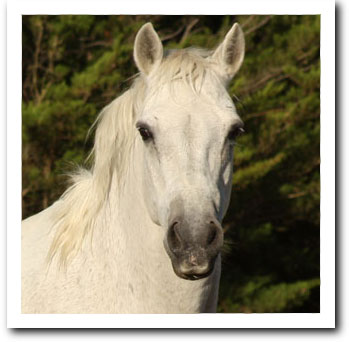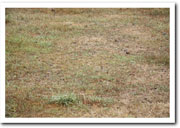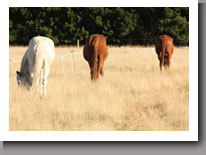The CalmHealthyHorses Plan
We've achieved outstanding results for both ourselves and our clients simply following the CalmHealthyHorses Plan - horse health bills go down while riding time and enjoyment goes up.
The true personality of your horse will be revealed.
Fantastic coats and hooves.
Danny Boy pictured left is in his mid twenties - a laminitis sufferer over most of his life, he is now enjoying life and looking fabulous on the CalmHealthyHorses plan...
What to do Immediately...
Are You Feeding Extra Salt?
click here to find out why this so important!
Read about when NOT to ride!
For Serious/Dangerous Problems:
- ASAP remove the horse from the pasture into a good sized yard or 'dry lot' area.
It is vitally important there is NO green, even the shortest, most microscopic grass can often perpetuate these problems. Many people would say there was 'no grass' in the photo above but it is GREEN and it is those little green shoots that cause the electrolyte imbalance that can trigger head-flicking, laminitis, musculo-skeletal issues and 'bad' behaviours. (Click on image for bigger picture)
shortest, most microscopic grass can often perpetuate these problems. Many people would say there was 'no grass' in the photo above but it is GREEN and it is those little green shoots that cause the electrolyte imbalance that can trigger head-flicking, laminitis, musculo-skeletal issues and 'bad' behaviours. (Click on image for bigger picture)
You need a 'dry lot', somewhere there is NO GREEN to reverse these problems and when they are good again you can gradually introduce grass back into the diet. - Provide ad lib hay 24 hours.
In a net with a small mesh if you wish to slow down consumption (See Hay-Savers) Soak for at least an hour in a tub of water for laminitic/obesity cases (Read "Soaking Hay") - Give a feed every day of oaten chaff with copra for taste, crushed or boiled linseed or oil (for protein and omega 3’s) adding Premium MVA ( Supreme Vit & Min plus ShipShape in Australia ) SOS, GrazeEzy and extra salt. Add more oil, copra and/or rolled barley if you need to put weight on.
- Kelp
- Molasses
- Lucerne
- Protein Meals
- Many herbs
- Take a 'Before' photo or two and keep a diary to monitor improvements
- If your horse 'isn't right', 'isn't his normal self', is doing things that are 'out of character' then definitely don't ride him. I could literally fill the website with stories of accidents which have happened when people ignored these warning signs and 'rode them anyway'!
Remember: There is no such thing as ‘resistance’, just a desperate need for communication
(Dr Deb Bennett PhD)
- Sometimes it is best not to handle them at all for a week or so, just leave them alone (apart from feed and care). Best not to try to 'work through issues', it is not only risky but is also a complete waste of time and energy as the issues won't be there when the horse comes back to normal.
(See Success Stories)
Less Serious Problems
(and when you cannot manage grass intake)

- Still feed hay every day. The fibre will keep the hind-gut flora healthy and a by-product of this is the production of B vitamins which contribute significantly to a calm healthy horse.
- Eliminate high potassium feeds
- In addition to feeding salt and the vitamins and minerals add GrazeEzy, starting with 10gms per feed (twice daily where possible). Every 3 days up the dose by 10gms per feed. Keep increasing the dose until ‘it works’. If manures go soft then reduce to the previous dose.
How do you know when your horse is OK to ride again?
This is easy. He will be normal in every way. He won’t ‘twitch when you touch him, won’t mind being brushed, saddled, girthed.
He won’t be at all twitchy around the ears or difficult to bridle. Will be able to be lunged at the walk, trot and canter with completely normal gaits and smooth upward and downward transitions.
He won’t be spooky or jumpy. His eye will be big and soft. He won’t be ridiculously herd-bound, wanting to put his head up and go too fast.
He will be calm and responsive and a pleasure to ride!
Don’t ride a horse that is not functioning normally! It is that simple.
Long Term...
1. Correctly feed the flora in the hind-gut
The bulk of your horse's diet needs to consist of a constant stream of structural carbohydrate (coarse fibrous material): mature grass, hay, non legume chaffs, beet. Soak hay for a minimum of one hour for obese, insulin resistant or laminitic horses and ponies.
2. Non-structural carbohydrate (NSC's) Sugar should be by far the smaller part of your horse's diet : green, growing grass, grains, molasses. Adjust according to your horse's workload. Obese, insulin resistant or laminitic horses should have very low NSC (sugar) diets.
3. Take care of your horse's vitamin & mineral requirements with Premium NZ Horse Minerals the dose is determined by the horse's weight and should be fed all year round. A deficiency of any one vitamin or mineral can upset all the rest.
Premium NZ Horse Minerals contains all the vitamins and minerals in organic form, required to maintain good health, shiny coats, strong hooves and a longer, useful life.
Premium MVA contains the same as the Premium plus bio-available amino acids - a potassium-free source of protein for performance and competition horses, growing and elderly horses.
4. Add 'AlleviateC' to promote superior nerve and muscle function in your riding and performance horses. AlleviateC should be fed all year round. The calcium & magnesium in AlleviateC are many times more absorbable than regular forms and will promote
- Maximum range of motion for the stride in dressage, jumping and racing.
- Comfortable gaits to ride for recreational horse riders. Horses that can’t stretch out in the walk, or are short-stepping and choppy at the trot and/or bunny-hopping at the canter are no fun to ride.
- Dilation of the bronchial tubes (opening of the airways) and arteries for maximum oxygen delivery and stamina
5. XtraCal – when additional calcium is required. When you add calcium in the situations listed below you also need to add the various co-factors which ensure calcium reaches its destinations in the body (Magnesium, phosphorous, boron, Vitamin D)
Xtra Cal complements Premium New Zealand Horse Minerals which supply everything else.
The dose rates, clearly outlined on the label, can be adjusted according to whether the horse is
- Breeding
- Pregnant
- lactating
- Growing
- working hard
- grazing oxalate pastures.
6. GrazeEzy – when it is difficult to control grass intake. Graze Ezy helps horses deal with problem grass.
7. Keep some Alleviate on hand. This special organic magnesium is perfect for whenever the grass grows rapidly and your horse gets tight, tense, spooky, short-stepping, herd-bound, has Attention Deficit Disorder or the night before competitions or any stressful event.
8. Add plain salt. The dose rate depends on their situation so full requirements may not be met in Premium NZ Horse Minerals. 10gms per 100kg of body weight is a good starting point and can be adjusted according to work load, whether they are sweating heavily or consuming rapidly growing grass and should be fed all year round. Salt acts to buffer excess potassium, also ensuring that the horse drinks enough water. Clean drinking water should be available at all times.
9. Pasture management: Formulate a plan to eliminate harmful pasture species and replace with horse-friendly varieties.
Rye-grass, clover, phalaris and paspalum, all pose serious health hazards to horses and will impact on your enjoyment and your pocket, not to mention your horse's quality of life. Cat's ear (dandelion look-alike), Cape weed and any other weeds poisonous to horses need to be removed.
Read ...
Pasture management
Plants to Eliminate
“Dry Lot Options”
 Calm Healthy Horses
Calm Healthy Horses